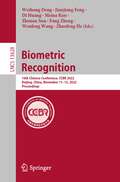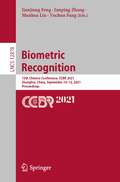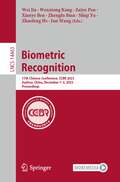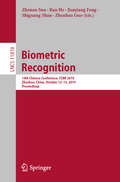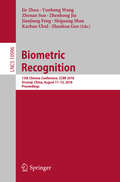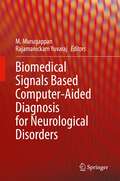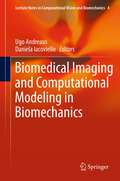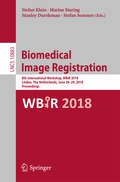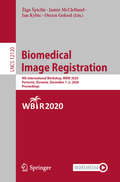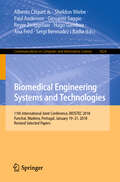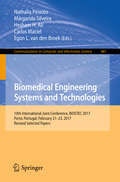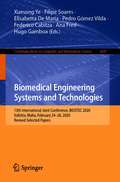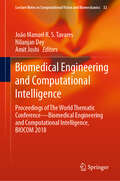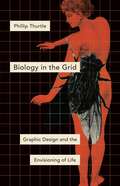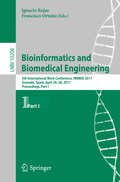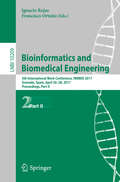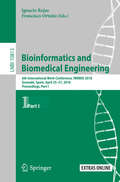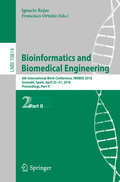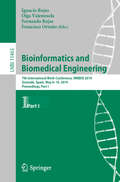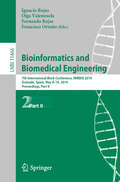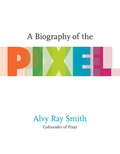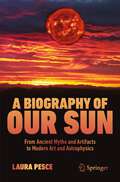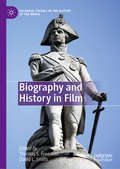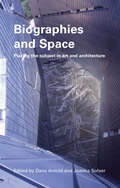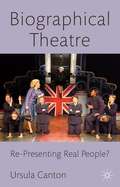- Table View
- List View
Biometric Recognition: 16th Chinese Conference, CCBR 2022, Beijing, China, November 11–13, 2022, Proceedings (Lecture Notes in Computer Science #13628)
by Weihong Deng Jianjiang Feng Di Huang Meina Kan Zhenan Sun Fang Zheng Wenfeng Wang Zhaofeng HeThis book constitutes the proceedings of the 16th Chinese Conference on Biometric Recognition, CCBR 2022, which took place in Beijing, China, in November 2022.The 70 papers presented in this volume were carefully reviewed and selected from 115 submissions. The papers cover a wide range of topics such as Fingerprint, Palmprint and Vein Recognition; Face Detection, Recognition and Tracking; Gesture and Action Recognition; Affective Computing and Human-Computer Interface; Speaker and Speech Recognition; Gait, Iris and Other Biometrics; Multi-modal Biometric Recognition and Fusion; Quality Evaluation and Enhancement of Biometric Signals; Animal Biometrics; Trustworthy, Privacy and Personal Data Security; Medical and Other Applications.
Biometric Recognition: 15th Chinese Conference, CCBR 2021, Shanghai, China, September 10–12, 2021, Proceedings (Lecture Notes in Computer Science #12878)
by Jianjiang Feng Junping Zhang Manhua Liu Yuchun FangThe LNCS volume 12878 constitutes the proceedings of the 15th Chinese Conference on Biometric Recognition, held in Shanghai, China, in September 2021.The 53 papers presented in this book were carefully reviewed and selected from 72 submissions. The papers cover a wide range of topics such as multi-modal biometrics and emerging biometrics; hand biometrics; facial biometrics; and speech biometrics.
Biometric Recognition: 17th Chinese Conference, CCBR 2023, Xuzhou, China, December 1–3, 2023, Proceedings (Lecture Notes in Computer Science #14463)
by Wei Jia Wenxiong Kang Zaiyu Pan Xianye Ben Zhengfu Bian Shiqi Yu Zhaofeng He Jun WangThis book constitutes the proceedings of the 17th Chinese Conference, CCBR 2023, held in Xuzhou, China, during December 1–3, 2023. The 41 full papers included in this volume were carefully reviewed and selected from 79 submissions. The volume is divided in topical sections named: Fingerprint, Palmprint and Vein Recognition; Face Detection, Recognition and Tracking; Affective Computing and Human-Computer Interface; Trustworthy, Privacy and Personal Data Security; Medical and Other Applications.
Biometric Recognition: 14th Chinese Conference, CCBR 2019, Zhuzhou, China, October 12–13, 2019, Proceedings (Lecture Notes in Computer Science #11818)
by Zhenan Sun Ran He Jianjiang Feng Shiguang Shan Zhenhua GuoThe LNCS volume 11818 constitutes the proceedings of the 14th Chinese Conference on Biometric Recognition, held in Zhuzhou, China, in October 2019. The 56 papers presented in this book were carefully reviewed and selected from 74 submissions. The papers cover a wide range of topics such as face recognition and analysis; hand-based biometrics; eye-based biometrics; gesture, gait, and action; emerging biometrics; feature extraction and classification theory; and behavioral biometrics.
Biometric Recognition: 13th Chinese Conference, CCBR 2018, Urumqi, China, August 11-12, 2018, Proceedings (Lecture Notes in Computer Science #10996)
by Jie Zhou Yunhong Wang Zhenan Sun Zhenhong Jia Jianjiang Feng Shiguang Shan Kurban Ubul Zhenhua GuoThe LNCS volume 10996 constitutes the proceedings of the 13th Chinese Conference on Biometric Recognition, held in Urumchi, China, in August 2018. The 79 full papers and 67 poster papers presented were carefully reviewed and selected from 112 submissions. The papers cover a wide range of topics such as Biometrics, Speech recognition, Activity recognition and understanding, Online handwriting recognition, System forensics, Multi-factor authentication, Graphical and visual passwords.
Biomedical Signals Based Computer-Aided Diagnosis for Neurological Disorders
by M. Murugappan Rajamanickam YuvarajBiomedical signals provide unprecedented insight into abnormal or anomalous neurological conditions. The computer-aided diagnosis (CAD) system plays a key role in detecting neurological abnormalities and improving diagnosis and treatment consistency in medicine. This book covers different aspects of biomedical signals-based systems used in the automatic detection/identification of neurological disorders. Several biomedical signals are introduced and analyzed, including electroencephalogram (EEG), electrocardiogram (ECG), heart rate (HR), magnetoencephalogram (MEG), and electromyogram (EMG). It explains the role of the CAD system in processing biomedical signals and the application to neurological disorder diagnosis. The book provides the basics of biomedical signal processing, optimization methods, and machine learning/deep learning techniques used in designing CAD systems for neurological disorders.
Biomedical Imaging and Computational Modeling in Biomechanics (Lecture Notes in Computational Vision and Biomechanics #4)
by Daniela Iacoviello Ugo AndreausThis book collects the state-of-art and new trends in image analysis and biomechanics. It covers a wide field of scientific and cultural topics, ranging from remodeling of bone tissue under the mechanical stimulus up to optimizing the performance of sports equipment, through the patient-specific modeling in orthopedics, microtomography and its application in oral and implant research, computational modeling in the field of hip prostheses, image based model development and analysis of the human knee joint, kinematics of the hip joint, micro-scale analysis of compositional and mechanical properties of dentin, automated techniques for cervical cell image analysis, and biomedical imaging and computational modeling in cardiovascular disease. The book will be of interest to researchers, Ph.D students, and graduate students with multidisciplinary interests related to image analysis and understanding, medical imaging, biomechanics, simulation and modeling, experimental analysis
Biomedical Image Registration: 8th International Workshop, WBIR 2018, Leiden, The Netherlands, June 28-29, 2018, Proceedings (Lecture Notes in Computer Science #10883)
by Stefan Klein Marius Staring Stanley Durrleman Stefan SommerThis book constitutes the refereed proceedings of the 8th International Workshop on Biomedical Image Registration, WBIR 2018, held in Leiden, The Netherlands, in June 2018. The 11 full and poster papers included in this volume were carefully reviewed and selected from 17 submitted papers. The papers are organized in the following topical sections: Sliding Motion, Groupwise Registration, Acceleration, and Applications and Evaluation.
Biomedical Image Registration: 9th International Workshop, WBIR 2020, Portorož, Slovenia, December 1–2, 2020, Proceedings (Lecture Notes in Computer Science #12120)
by Žiga Špiclin Jamie McClelland Jan Kybic Orcun GokselThis book constitutes the refereed proceedings of the 9th International Workshop on Biomedical Image Registration, WBIR 2020, which was supposed to be held in Portorož, Slovenia, in June 2020. The conference was postponed until December 2020 due to the COVID-19 pandemic. The 16 full and poster papers included in this volume were carefully reviewed and selected from 22 submitted papers. The papers are organized in the following topical sections: Registration initialization and acceleration, interventional registration, landmark based registration, multi-channel registration, and sliding motion.
Biomedical Engineering Systems and Technologies: 11th International Joint Conference, BIOSTEC 2018, Funchal, Madeira, Portugal, January 19–21, 2018, Revised Selected Papers (Communications in Computer and Information Science #1024)
by Alberto Cliquet Jr. Sheldon Wiebe Paul Anderson Giovanni Saggio Reyer Zwiggelaar Hugo Gamboa Ana Fred Sergi Bermúdez i BadiaThis book constitutes the thoroughly refereed post-conference proceedings of the 11th International Joint Conference on Biomedical Engineering Systems and Technologies, BIOSTEC 2018, held in Funchal, Madeira, Portugal, in January 2018.The 25 revised full papers presented were carefully reviewed and selected from a total of 299 submissions. The papers are organized in topical sections on biomedical electronics and devices; bioimaging; bioinformatics models, methods and algorithms; health informatics.
Biomedical Engineering Systems and Technologies: 10th International Joint Conference, Biostec 2017, Porto, Portugal, February 21-23, 2017, Revised Selected Papers (Communications In Computer And Information Science #881)
by Egon L. van den Broek Carlos Maciel Hesham H. Ali Margarida Silveira Nathalia PeixotoThis book constitutes the thoroughly refereed post-conference proceedings of the 10th International Joint Conference on Biomedical Engineering Systems and Technologies, BIOSTEC 2017, held in Porto, Portugal, in February 2017.The 20 revised full papers presented were carefully reviewed and selected from a total of 297 submissions. The papers are organized in topical sections on biomedical electronics and devices; bioimaging; bioinformatics models, methods and algorithms; bio-inspired systems and signal processing; and health informatics.
Biomedical Engineering Systems and Technologies: 13th International Joint Conference, BIOSTEC 2020, Valletta, Malta, February 24–26, 2020, Revised Selected Papers (Communications in Computer and Information Science #1400)
by Xuesong Ye Filipe Soares Elisabetta De Maria Pedro Gómez Vilda Federico Cabitza Ana Fred Hugo GamboaThis book constitutes extended and revised versions of the selected papers from the 13th International Joint Conference on Biomedical Engineering Systems and Technologies, BIOSTEC 2020, held in Valletta, Malta, in February 2020.The 29 revised and extended full papers presented were carefully reviewed and selected from a total of 363 submissions. The papers are organized in topical sections on biomedical electronics and devices; bioimaging; bioinformatics models, methods and algorithms; bio-inspired systems and signal processing; health informatic
Biomedical Engineering and Computational Intelligence: Proceedings of The World Thematic Conference—Biomedical Engineering and Computational Intelligence, BIOCOM 2018 (Lecture Notes in Computational Vision and Biomechanics #32)
by João Manuel R. S. Tavares Nilanjan Dey Amit JoshiThis book reports on timely research at the interface between biomedical engineering and intelligence technologies applied to biology and healthcare. It covers cutting-edge methods applied to biomechanics and robotics, EEG time series analysis, blood glucose prediction models, among others. It includes ten chapters, which were selected upon a rigorous peer-review process and presented at the 1st World Thematic Conference - Biomedical Engineering and Computational Intelligence, BIOCOM 2018, held in London, United Kingdom, during October 30–31, 2018.
Biology in the Grid: Graphic Design and the Envisioning of Life (Posthumanities)
by Phillip ThurtleHow grids paved the way for our biological understanding of organisms As one of the most visual sciences, biology has an aesthetic dimension that lends force and persuasion to scientific arguments: how things are arranged on a page, how texts are interspersed with images, and how images are composed reflect deep-seated beliefs about how life exists on Earth. Biology in the Grid traces how our current understanding of life and genetics emerged from the pervasive nineteenth- and twentieth-century graphic form of the grid, which allowed disparate pieces of information to form what media theorist Vilém Flusser called “technical images.”Phillip Thurtle explains how the grid came to dominate biology in the twentieth century, transforming biologists’ beliefs about how organisms were constructed. He demonstrates how this shift in our understanding of biological grids enabled new philosophies in endeavors such as advertising, entertainment, and even political theory. The implications of the arguments in Biology in the Grid are profound, touching on matters as fundamental as desire, our understanding of our bodies, and our view of how society is composed. Moreover, Thurtle’s beautifully written, tightly focused arguments allow readers to apply his claims to new disciplines and systems. Bristling with insight and potential, Biology in the Grid ultimately suggests that such a grid-organized understanding of natural life inevitably has social and political dimensions, with society recognized as being made of interchangeable, regulated parts rather than as an organic whole.
Bioinformatics and Biomedical Engineering: 5th International Work-Conference, IWBBIO 2017, Granada, Spain, April 26–28, 2017, Proceedings, Part I (Lecture Notes in Computer Science #10208)
by Ignacio Rojas and Francisco OrtuñoThis two volume set LNBI 10208 and LNBI 10209 constitutes the proceedings of the 5th International Work-Conference on Bioinformatics and Biomedical Engineering, IWBBIO 2017, held in Granada, Spain, in April 2017. The 122 papers presented were carefully reviewed and selected from 309 submissions. The scope of the conference spans the following areas: advances in computational intelligence for critical care; bioinformatics for healthcare and diseases; biomedical engineering; biomedical image analysis; biomedical signal analysis; biomedicine; challenges representing large-scale biological data; computational genomics; computational proteomics; computational systems for modeling biological processes; data driven biology - new tools, techniques and resources; eHealth; high-throughput bioinformatic tools for genomics; oncological big data and new mathematical tools; smart sensor and sensor-network architectures; time lapse experiments and multivariate biostatistics.
Bioinformatics and Biomedical Engineering: 5th International Work-Conference, IWBBIO 2017, Granada, Spain, April 26–28, 2017, Proceedings, Part II (Lecture Notes in Computer Science #10209)
by Ignacio Rojas and Francisco OrtuñoThis two volume set LNBI 10208 and LNBI 10209 constitutes the proceedings of the 5th International Work-Conference on Bioinformatics and Biomedical Engineering, IWBBIO 2017, held in Granada, Spain, in April 2017. The 122 papers presented were carefully reviewed and selected from 309 submissions. The scope of the conference spans the following areas: advances in computational intelligence for critical care; bioinformatics for healthcare and diseases; biomedical engineering; biomedical image analysis; biomedical signal analysis; biomedicine; challenges representing large-scale biological data; computational genomics; computational proteomics; computational systems for modeling biological processes; data driven biology - new tools, techniques and resources; eHealth; high-throughput bioinformatic tools for genomics; oncological big data and new mathematical tools; smart sensor and sensor-network architectures; time lapse experiments and multivariate biostatistics.
Bioinformatics and Biomedical Engineering: 6th International Work-Conference, IWBBIO 2018, Granada, Spain, April 25–27, 2018, Proceedings, Part I (Lecture Notes in Computer Science #10813)
by Ignacio Rojas Francisco OrtuñoThis two-volume set LNBI 10813 and LNBI 10814 constitutes the proceedings of the 6th International Work-Conference on Bioinformatics and Biomedical Engineering, IWBBIO 2018, held in Granada, Spain, in April 2018.The 88 regular papers presented were carefully reviewed and selected from 273 submissions. The scope of the conference spans the following areas: bioinformatics for healthcare and diseases; bioinformatics tools to integrate omics dataset and address biological question; challenges and advances in measurement and self-parametrization of complex biological systems; computational genomics; computational proteomics; computational systems for modelling biological processes; drug delivery system design aided by mathematical modelling and experiments; generation, management and biological insights from big data; high-throughput bioinformatic tools for medical genomics; next generation sequencing and sequence analysis; interpretable models in biomedicine and bioinformatics; little-big data. Reducing the complexity and facing uncertainty of highly underdetermined phenotype prediction problems; biomedical engineering; biomedical image analysis; biomedical signal analysis; challenges in smart and wearable sensor design for mobile health; and healthcare and diseases.
Bioinformatics and Biomedical Engineering: 6th International Work-Conference, IWBBIO 2018, Granada, Spain, April 25–27, 2018, Proceedings, Part II (Lecture Notes in Computer Science #10814)
by Ignacio Rojas Francisco OrtuñoThis two volume set LNBI 10813 and LNBI 10814 constitutes the proceedings of the 6th International Work-Conference on Bioinformatics and Biomedical Engineering, IWBBIO 2018, held in Granada, Spain, in April 2018.The 88 regular papers presented were carefully reviewed and selected from 273 submissions. The scope of the conference spans the following areas: bioinformatics for healthcare and diseases; bioinformatics tools to integrate omics dataset and address biological question; challenges and advances in measurement and self-parametrization of complex biological systems; computational genomics; computational proteomics; computational systems for modelling biological processes; drug delivery system design aided by mathematical modelling and experiments; generation, management and biological insights from big data; high-throughput bioinformatic tools for medical genomics; next generation sequencing and sequence analysis; interpretable models in biomedicine and bioinformatics; little-big data. Reducing the complexity and facing uncertainty of highly underdetermined phenotype prediction problems; biomedical engineering; biomedical image analysis; biomedical signal analysis; challenges in smart and wearable sensor design for mobile health; and healthcare and diseases.
Bioinformatics and Biomedical Engineering: 7th International Work-Conference, IWBBIO 2019, Granada, Spain, May 8-10, 2019, Proceedings, Part I (Lecture Notes in Computer Science #11465)
by Ignacio Rojas Olga Valenzuela Fernando Rojas Francisco OrtuñoThe two-volume set LNBI 11465 and LNBI 11466 constitutes the proceedings of the 7th International Work-Conference on Bioinformatics and Biomedical Engineering, IWBBIO 2019, held in Granada, Spain, in May 2019. The total of 97 papers presented in the proceedings, was carefully reviewed and selected from 301 submissions. The papers are organized in topical sections as follows: Part I: High-throughput genomics: bioinformatics tools and medical applications; omics data acquisition, processing, and analysis; bioinformatics approaches for analyzing cancer sequencing data; next generation sequencing and sequence analysis; structural bioinformatics and function; telemedicine for smart homes and remote monitoring; clustering and analysis of biological sequences with optimization algorithms; and computational approaches for drug repurposing and personalized medicine. Part II: Bioinformatics for healthcare and diseases; computational genomics/proteomics; computational systems for modelling biological processes; biomedical engineering; biomedical image analysis; and biomedicine and e-health.
Bioinformatics and Biomedical Engineering: 7th International Work-Conference, IWBBIO 2019, Granada, Spain, May 8-10, 2019, Proceedings, Part II (Lecture Notes in Computer Science #11466)
by Ignacio Rojas Olga Valenzuela Fernando Rojas Francisco OrtuñoThe two-volume set LNBI 11465 and LNBI 11466 constitutes the proceedings of the 7th International Work-Conference on Bioinformatics and Biomedical Engineering, IWBBIO 2019, held in Granada, Spain, in May 2019. The total of 97 papers presented in the proceedings, was carefully reviewed and selected from 301 submissions. The papers are organized in topical sections as follows: Part I: High-throughput genomics: bioinformatics tools and medical applications; omics data acquisition, processing, and analysis; bioinformatics approaches for analyzing cancer sequencing data; next generation sequencing and sequence analysis; structural bioinformatics and function; telemedicine for smart homes and remote monitoring; clustering and analysis of biological sequences with optimization algorithms; and computational approaches for drug repurposing and personalized medicine. Part II: Bioinformatics for healthcare and diseases; computational genomics/proteomics; computational systems for modelling biological processes; biomedical engineering; biomedical image analysis; and biomedicine and e-health.
A Biography of the Pixel (Leonardo)
by Alvy Ray SmithThe pixel as the organizing principle of all pictures, from cave paintings to Toy Story.The Great Digital Convergence of all media types into one universal digital medium occurred, with little fanfare, at the recent turn of the millennium. The bit became the universal medium, and the pixel--a particular packaging of bits--conquered the world. Henceforward, nearly every picture in the world would be composed of pixels--cell phone pictures, app interfaces, Mars Rover transmissions, book illustrations, videogames. In A Biography of the Pixel, Pixar cofounder Alvy Ray Smith argues that the pixel is the organizing principle of most modern media, and he presents a few simple but profound ideas that unify the dazzling varieties of digital image making. Smith's story of the pixel's development begins with Fourier waves, proceeds through Turing machines, and ends with the first digital movies from Pixar, DreamWorks, and Blue Sky. Today, almost all the pictures we encounter are digital--mediated by the pixel and irretrievably separated from their media; museums and kindergartens are two of the last outposts of the analog. Smith explains, engagingly and accessibly, how pictures composed of invisible stuff become visible--that is, how digital pixels convert to analog display elements. Taking the special case of digital movies to represent all of Digital Light (his term for pictures constructed of pixels), and drawing on his decades of work in the field, Smith approaches his subject from multiple angles--art, technology, entertainment, business, and history. A Biography of the Pixel is essential reading for anyone who has watched a video on a cell phone, played a videogame, or seen a movie.
A Biography of Our Sun: From Ancient Myths and Artifacts to Modern Art and Astrophysics
by Laura PesceThis book is for everyone curious about the Sun and how it has been perceived throughout human history, including the modern scientific view. Beginning with ancient myths and legends, superstitions, art and poetry, the book proceeds to explain the amazing composition of our star, how it produces the heat and light on which all life depends, as well as touching the harvesting of solar energy that is becoming so essential in the modern world. The book is illustrated by the author's own artwork and includes first-hand scientific information provided in interviews with professional astrophysicists.
Biography and History in Film (Palgrave Studies in the History of the Media)
by Thomas S. Freeman David L. SmithThe essays in this volume seek to analyze biographical films as representations of historical individuals and the times in which they lived. To do this, contributors examine the context in which certain biographical films were made, including the state of knowledge about their subjects at that moment, and what these films reveal about the values and purposes of those who created them. This is an original approach to biographical (as opposed to historical) films and one that has so far played little part in the growing literature on historical films. The films discussed here date from the 1920s to the 2010s, and deal with males and females in periods ranging from the Middle Ages to the end of the twentieth century. In the process, the book discusses how biographical films reflect changing attitudes towards issues such as race, gender and sexuality, and examines the influence of these films on popular perceptions of the past. The introduction analyses the nature of biographical films as a genre: it compares and contrasts the nature of biography on film with written biographies, and considers their relationship with the discipline of history. As the first collection of essays on this popular but understudied genre, this book will be of interest to historians as well as those in film and cultural studies.
Biographies & Space: Placing the Subject in Art and Architecture
by Dana Arnold Joanna Sofaer DerevenskiBringing together a collection of high-profile authors, Biographies and Space presents essays exploring the relationship between biography and space and how specific subjects are used as a means of explaining sets of social, cultural and spatial relationships. Biographical methods of historical investigation can bring out the authentic voice of subjects, revealing personal meanings and strategies in space as well as providing a means to analyze relations between the personal and the social. Writing about both actual (architectural) and imagined (pictorial) space, the authors consider issues of gender, childhood, sexuality and race, highlighting an increasing fluidity and interaction between theory, methods and history. Biographies and Space is an original and exciting new book, with direct relevance to both architectural and art history.
Biographical Theatre
by Ursula CantonMarilyn Monroe, Vincent van Gogh or the victims of rendition flights - the number and variety of historical and contemporary figures represented on British stages is amazing. This book develops a new theoretical framework for the representation of real life figures on stage and examines different ways in which they can be included in performances.
